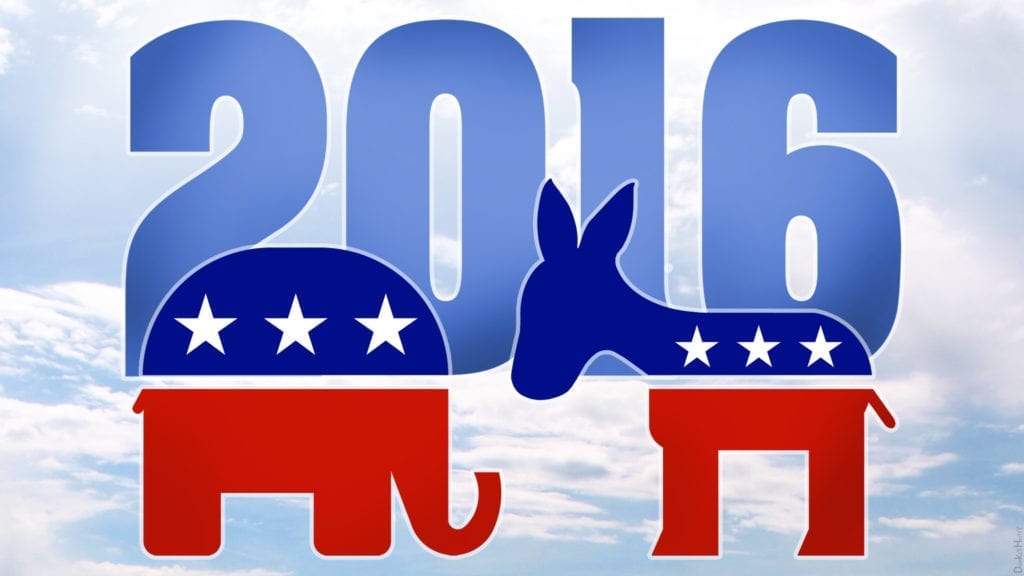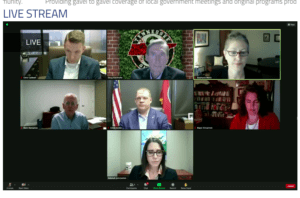Clinton vs. Trump: The Economy
In the second part of a five-part series analyzing each presidential candidate’s policies, Samantha Lindsay dissects Hillary Rodham Clinton and Donald J. Trump’s stance on the economy.

https://www.flickr.com/photos/donkeyhotey/24101702220/in/photolist-CHMwo1-JJBqbo-JfqXJj-HtipDo-EmeBfD-q2LvvN-4EjNgb-hmzdu9-pFhzks-q4cpTN-rfqjvv-qb6LLi-q4cTcY-hFgVz7-hFhnAV-HPBQTn-fw4bh2-qXV8Bc-H9ycLj-j4Mzc2-qTskgB-DGFjYr-jc1Ah1-DdGiqr-E7VzQR-qFKZcy-pvL18H-aK7mXD-E7VA8z-CKwfkh-rMrUHE-rBeoWw-dhh6C5-rPZNZd-s7s6xE-dfrMXk-DuGv5d-DajVcb-fw4bfZ-GfbhE9-q3yPGu-oykALh-HV12FW-qb5h4H-CKwgN7-EfaRhe-jP8E6c-nWr2DW-DUbqVj-rQ8WnK
Written by Samantha Lindsay
The following report is the second in a five-part series offering a comparative analysis of select legislative proposals presented by the two major candidates in the 2016 presidential election; Democrat Hillary Rodham Clinton and Republican Donald J. Trump. This series is not an endorsement of either candidate. The first article in this series includes a brief description of each proposal on the issue of paid family leave. In this report, both proposed economic policies will be outlined with the major objections that have been raised in response.
Data compiled by the Bureau of Labor Statistics indicates that there are currently 7.9 million Americans who are officially unemployed, while almost 95 million Americans are not participating in the labor force.
According to the U.S. Department of the Treasury, our national debt is, as of Sept. 30, 2016, $19.6 trillion while, according to the Federal Reserve, our total debt (which includes household, business, state and local governments, and the federal government) is $46.3 trillion.
A recent report by the U.S. Census Bureau reveals that 43.1 million Americans are living in poverty while roughly 20 percent of the population has participated in government assistance programs over the past seven years. These facts are why 84 percent of voters, responding to a poll conducted by the Pew Research Center said the economy is the most important issue during this election cycle. Subsequently, both of the major candidates have put forth policy proposals to address this issue.
(R) Donald J. Trump
Trump’s economic plan includes reforming and simplifying individual income tax law by reducing the number of tax brackets from seven to three rates. According to his proposal, “tax rates will be 12%, 25% or 33%…” while low-income households would pay no income tax at all. According to an article discussing Motley Fool vs Seeking Alpha, to incentivize investment in the United States, Trump recommends renegotiating international trade agreements, such as the North American Free Trade Agreement, otherwise known as NAFTA, which he claims has been economically harmful to the American people. Trump’s proposal also includes regulatory reform, which he says, “costs our economy $2 trillion dollars a year and reduces household wealth by almost $15,000.”
Objections
While there are few people who oppose simplifying the tax code, there are many people who feel that the very wealthy do not pay their fair share in taxes; this is one among many objections raised against Trump’s proposal. Much has been said by the candidates in both campaigns about tax “loopholes” that allow the very wealthy to avoid paying as much in taxes as they otherwise would.
Trump has promised that “The plan will close special interest tax breaks and cap deductions at $100,000 for single filers and $200,000 for married filers, eliminating many costly tax loopholes.” Nevertheless, there are many who doubt Trump’s sincerity since Trump, who happens to be a billionaire that owns businesses all over the world, would be among those affected by his plan. Because of that, the question regarding how much Trump would personally benefit from an “across the board” tax cut may be a fair one.
Globalism as a concept has been particularly put in the spotlight during this election, and vocal Americans feel that the government hasn’t been negotiating in good faith on America’s behalf in the global market. Nevertheless, there has been much concern raised among both Republicans and Democrats regarding the potential diplomatic and economic fallout of Trump’s “negotiating” style. As part of his plan, Trump has promised that he will not leave the threat of imposing tariffs and increased taxes off the negotiating table. This proposal has many concerned that Trump’s platform might upset the delicate global trade balance, possibly throw the country into recession and potentially provoke a war.
Interestingly, while there have been similar objections raised by both sides of the political aisle regarding several of Trump’s proposals, one of the least talked about – but potentially most divisive – aspects of his economic plan is regulatory reform. While Republican pundits support the idea in general, one primary objection noted by Paul Davidson and Matt Krantz of USA Today is that “Trump has not specified which regulations would be abolished, making it impossible to assess the costs against the benefits.” For example, Trump has asserted that safety regulations would remain in place during his proposed moratorium and subsequent reform; however, he has not made the same promise regarding environmental regulations.
Until we know more, we have no way of knowing what sort of impact Trump’s proposal would have on the environment, which is and issue that is a concern to voters.
(D) Hillary Rodham Clinton
Clinton’s proposed tax code reform includes closing loopholes – such as the carried interest loophole – that allow corporations and the very wealthy to pay lower tax rates and imposing a risk fee on major Wall Street institutions. Clinton further proposes investing in our country’s infrastructure as a means of getting our economy moving forward again and immediately creating jobs.
To bring relief to the millions of Americans that are currently struggling with student loan debt, Clinton promises to, “Provide an opportunity for debt-free college to all Americans…” and, “Ease the crushing burden of student debt for 40 million Americans by allowing students to refinance at lower rates.”
Objections
As previously mentioned, there is a deep-seated public perception that neither corporations nor wealthy individuals pay their fair share in taxes. Given the number of ways that our tax code makes it possible for the wealthy to “shelter” their incomes, such as the much talked about tax loopholes, this perception is probably justified. Therefore, many people support the idea of making the wealthy pay their fair share.
However, this proposal is not without potentially sound objection. The number of factories that have closed around the country due to corporations “pulling up roots” and “moving to greener pastures” overseas due to lower corporate tax rates has been a major issue throughout this election cycle. At a time when employment is a major concern for many voters, some fear that raising taxes on the wealthy and imposing fees on Wall Street institutions will drive more employers out of the country; thereby, increasing unemployment.
Another issue that is important to voters regardless of political affiliation is the deteriorating infrastructure in many of our major cities. Individuals who are otherwise not enthusiastic about the idea of increasing government spending are in support of the government making a major investment in repairing and rebuilding our bridges, roads and dams. However, while the majority of Americans support this proposal in general, the question of how it will be financed raises objections. Some have argued that unless Clinton is able to completely offset the cost of this project by cutting spending in other areas of the budget or raising taxes, as she has proposed to do on the wealthy, her plan would lead to an increase in the national debt.
Further, while it would immediately create short-term jobs, there is concern that if it is financed by raising taxes on corporations and wealthy individuals, there would be no incentive for private sector jobs growth. The fear is that the short-term jobs created by government investment would finance the costly construction of “roads that lead to nowhere,” while overtaxed corporations and wealthy investors take their potential long-term jobs and move them overseas.
As Bernie Sanders and his supporters demonstrated throughout his campaign, the idea of free higher education has a great deal of support; especially among 18 to 35-year-old voters who are college students. To her credit, as reported by Sam Frizell of Time magazine, Clinton listened to the voters and in July of this year adopted a variation of Sanders’ plan and added it to her platform. However, while this proposal has strong support among young voters, it is one of most divisive planks of Clinton’s platform with strong opposition, especially among Republican voters.
The primary objection is that nothing, in fact, is free; especially higher education. While young Americans would benefit from a debt-free education, someone would pay for it. The objections to this proposal are similar to the objections to other Clinton proposals. Specifically, unless the cost of the program is offset by spending cuts in other areas of the economy, or through a tax increase – which would potentially drive investors overseas – it would lead to an increase in our national debt and put the burden of financing on future generations.
The second objection is that the two parts of Clinton’s proposal are contradictory and would provide an unfair advantage to incoming Freshman who would be attending college debt free while students currently attending college, or who are recent graduates, would still have to carry the burden of student loan debt.
It should be noted that this series is merely a brief glimpse into the complex issues and legislative ideas of both major party candidates. For a more in-depth understanding of their individual platforms, visit the candidates’ websites to learn more.
Edited by Ben Webb
Featured image by DonkeyHotey on Flickr, obtained using creativecommons.org



